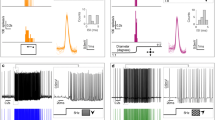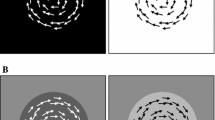Abstract
Extracellular recordings were made from a directionally selective neuron in the ventral nerve cord of mantises. The neuron’s preferred direction of motion was forward and upward over the compound eye contralateral to its axon at the cervical connective. The neuron was sensitive to wide-field motion stimuli, resistant to habituation, and showed transient excitation in response to light ON and OFF stimuli. Its responses to drifting gratings depended on the temporal frequency and contrast of the stimulus. These results suggest that the neuron receives input from correlation-type motion detectors.










Similar content being viewed by others
References
Berger FA (1985) Morphologie und Physiologie einiger visueller Interneuronen in den optischen Ganglien der Gottesanbeterin Mantis religiosa. Doctoral thesis, Universität Düsseldorf
Borst A, Egelhaaf M (1989) Principles of visual motion detection. TINS 12:297–306
Egelhaaf M, Borst A (1989) Transient and steady-state response properties of movement detectors. J Opt Soc Am A 6:116–127
Griss C, Rowell CHF (1986) Three descending interneurons reporting deviation from course in the locust. I. Anatomy. J Comp Physiol A 158:765–774
Ibbotson MR (1991) Wide-field motion-sensitive neurons tuned to horizontal movement in the honeybee, Apis mellifera. J Comp Physiol A 168:91–102
Ibbotson MR, Goodman LJ (1990) Response characteristics of four wide-field motion-sensitive descending interneurones in Apis mellifera. J Exp Biol 148:255–279
Koenderink JJ (1986) Optic flow. Vis Res 26:161–180
Maddess T (1986) Afterimage-like effects in the motion-sensitive neuron H1. Proc R Soc Lond B 228:433–459
Maxwell MR (1999) Mating behavior. In: Prete FR, Wells H, Wells PH, Hurd LE (eds) The praying mantids. Johns Hopkins University Press, Baltimore, pp 69–89
Miles FA, Wallman J (eds) (1993) Visual motion and its role in the stabilization of gaze. Elsevier, Amsterdam
Olberg RM (1981a) Object- and self-movement detectors in the ventral nerve cord of the dragonfly. J Comp Physiol 141:327–334
Olberg RM (1981b) Parallel encoding of direction of wind, head, abdomen, and visual pattern movement by single interneurons in the dragonfly. J Comp Physiol 142:27–41
Reichardt W (1987) Evaluation of optical motion information by movement detectors. J Comp Physiol A 161:533–547
Rind FC (1983) A directionally sensitive motion detecting neurone in the brain of a moth. J Exp Biol 102:253–271
Rind FC (1990) A directionally selective motion-detecting neuron in the brain of the locust: physiological and morphological characterization. J Exp Biol 149:1–19
Rossel S (1979) Regional differences in photoreceptor performance in the eye of the praying mantis. J Comp Physiol 131:95–112
Rowell CHF, Reichert H (1986) Three descending interneurons reporting deviation from course in the locust. II. Physiology. J Comp Physiol A 158:775–794
Yamawaki Y (2000) Effects of luminance, size, and angular velocity on the recognition of nonlocomotive prey models by the praying mantis. J Ethol 18:85–90
Yamawaki Y, Toh Y (2009) Responses of descending neurons to looming stimuli in the praying mantis Tenodera aridifolia. J Comp Physiol A 195:253–264
Acknowledgments
This work was supported by a Grant-in-Aid for Young Scientists (B) from MEXT to Y.Y. (17770061).
Author information
Authors and Affiliations
Corresponding author
Rights and permissions
About this article
Cite this article
Yamawaki, Y., Toh, Y. A descending contralateral directionally selective movement detector in the praying mantis Tenodera aridifolia . J Comp Physiol A 195, 1131–1139 (2009). https://doi.org/10.1007/s00359-009-0485-9
Received:
Revised:
Accepted:
Published:
Issue Date:
DOI: https://doi.org/10.1007/s00359-009-0485-9




